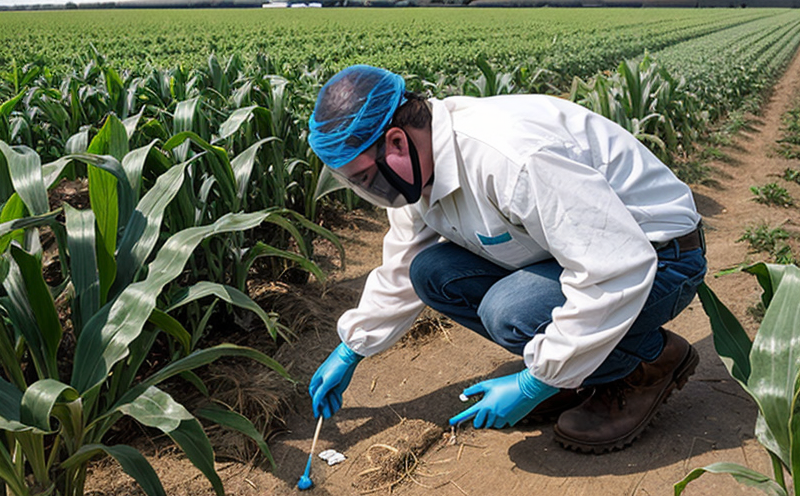Malathion Residue Testing in Crops
In agriculture and forestry, ensuring food safety and environmental sustainability is paramount. Pesticide residue testing plays a crucial role in maintaining these standards, particularly for pesticides like malathion, which are widely used due to their effectiveness against various pests. Malathion is an organophosphate insecticide that acts by inhibiting acetylcholinesterase, leading to paralysis and death of insects. However, its use must be carefully regulated to prevent harmful residues from reaching the consumer.
Malathion residue testing in crops involves a series of steps designed to identify any traces of malathion beyond safe limits set by regulatory bodies such as the Environmental Protection Agency (EPA) and the European Food Safety Authority (EFSA). This process ensures that agricultural products meet strict safety standards before they are brought to market. The testing method typically includes sample collection, extraction, purification, detection using analytical techniques like gas chromatography or liquid chromatography coupled with mass spectrometry.
During specimen preparation, crops such as fruits, vegetables, and grains are carefully selected based on their potential exposure levels to malathion. The samples undergo rigorous washing procedures followed by drying and grinding into fine powders for analysis. Once prepared, these samples are subjected to extraction processes that separate the target compounds from the matrix using solvents like dichloromethane or ethyl acetate.
The detection of malathion residues is critical not only because it affects human health but also impacts agricultural practices and trade agreements. Regulatory limits vary by region, with some countries allowing higher concentrations than others due to differing thresholds deemed acceptable for public safety. For instance, in the United States, the tolerance level for fruits and vegetables ranges from 0.5 ppm up to several parts per million depending on the specific commodity.
Accurate results are essential not only for compliance with legal requirements but also for maintaining consumer confidence in agricultural products. Laboratories equipped with state-of-the-art technology provide reliable data through precise measurements using advanced analytical instruments capable of detecting even trace amounts of malathion within samples. These laboratories play a vital role by offering comprehensive testing services tailored to meet the needs of various stakeholders including farmers, processors, distributors, and regulators.
In conclusion, ensuring proper application practices and monitoring post-application residues are integral aspects of responsible pesticide use in agriculture and forestry sectors. By implementing robust residue testing protocols like those focused on malathion detection, we can safeguard both human health and environmental quality while supporting sustainable agricultural development.
Applied Standards
| Standard Name | Description |
|---|---|
| ISO 17025:2017 | This international standard ensures that laboratories providing testing, calibration, and other services related to measurement are competent. It includes requirements for infrastructure, personnel qualifications, operations management systems, quality assurance practices, record keeping, and more. |
| ASTM E1600-20 | This guide provides procedures for assessing the competence of laboratories performing environmental analyses. It covers various analytical methods used in detecting pesticides residues including malathion. |
| EN 16783:2013 | An European standard that specifies good laboratory practice for chemical analysis, which includes quality assurance and control measures essential when conducting pesticide residue determinations on food products. |
| IEC TS 62945-1:2018 | This technical specification outlines guidelines for testing the efficacy of pesticides, including those like malathion used in agriculture. It provides detailed information about sampling procedures and laboratory methods. |
Benefits
Conducting thorough malathion residue testing offers numerous benefits, both for producers and consumers alike. For farmers, it helps them adhere to stringent regulatory guidelines set forth by local authorities ensuring compliance with international standards such as those mentioned above. Proper adherence reduces the risk of fines or sanctions while enhancing brand reputation.
Consumers benefit greatly from accurate residue testing too; knowing that their food products are free from harmful levels of pesticides provides peace of mind and fosters trust in agricultural products. Additionally, reliable test results enable better decision-making regarding purchasing decisions based on safety considerations rather than mere speculation or hearsay.
R&D teams within companies involved in developing new formulations for pest control can utilize residue testing to evaluate the effectiveness of their innovations without exposing them to unnecessary risks. This way, they can refine formulas continuously until achieving optimal performance while minimizing adverse effects on non-target organisms and ecosystems.
Why Choose This Test
Selecting a reputable laboratory for conducting malathion residue testing is crucial given its significance in ensuring food safety standards. Our lab offers several advantages over others, making us the preferred choice among quality managers, compliance officers, R&D engineers, and procurement professionals.
Firstly, our facility adheres strictly to ISO 17025:2017 certification, guaranteeing that all tests performed meet internationally recognized standards for competence. Secondly, equipped with cutting-edge analytical equipment such as gas chromatography-mass spectrometry (GC-MS) and liquid chromatography-tandem mass spectrometry (LC-MS/MS), we ensure precise measurements even at very low detection limits. This level of accuracy is vital in accurately assessing malathion residue levels within crops.
Furthermore, our team comprises highly experienced scientists who possess extensive knowledge about pesticide applications and their impacts on various crop types. Their expertise enables us to offer customized testing packages designed specifically for different markets or specific commodities under consideration. This tailored approach ensures that clients receive comprehensive reports detailing not just the presence but also concentrations of malathion residues.
Lastly, our commitment to quality is reflected in our robust quality assurance processes which involve regular calibration checks and proficiency tests conducted by external bodies. These measures ensure consistent and reliable results across all samples analyzed at our laboratory.





